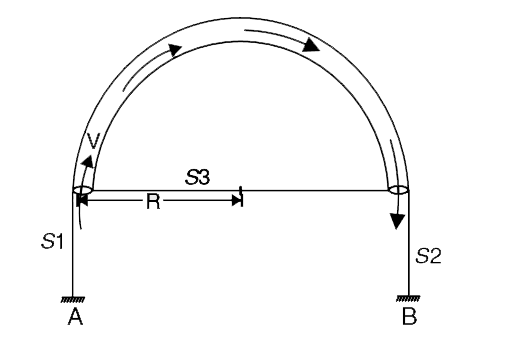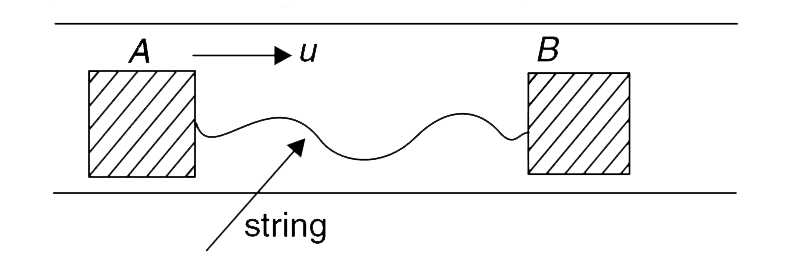State in the following cases, whether the motion is one, two or three dimensional motion is one, two or three dimesional motion: (a) a dite fluing onwindy day (b) a speeding car on a long straight high way (c ) a carrom coin rebounding from the side if the board (d) a plane revolving around its star.
(a) The motion of kite in the sky is three dinensional motion because the kite while flying may be changing the direction as well as lonsing or gaining the height, i. e. the motion is in space.
(b) The motion of speeding car on a long straight highway is one dimesional motion , since the motion , since the motion is confined in the place of coard.
(c ) The motion of a carrom coin rebunding from the side of the board is two dimensional motion, since the motion is confined in the place of board.
(d) The motion of a placet revolving aruase the motion is confined in a fixek plane.
Topper's Solved these Questions
- KINEMATICSBOOK - PRADEEPCHAPTER - KINEMATICSEXERCISE - 1 Con ceptual Problems
14 Videos
- KINEMATICSBOOK - PRADEEPCHAPTER - KINEMATICSEXERCISE - 2 Con ceptual Problems
15 Videos
- KINEMATICSBOOK - PRADEEPCHAPTER - KINEMATICSEXERCISE - 4 SolvedExamples
31 Videos
- GRAVIATIONBOOK - PRADEEPCHAPTER - GRAVIATIONEXERCISE - Assertion-Reason Type Questions
19 Videos
- LAWS OF MOTIONBOOK - PRADEEPCHAPTER - LAWS OF MOTIONEXERCISE - Assertion- Reason Type Questions
17 Videos
Similar Questions
Given below are some examples of motion. State in each case. If the motion is one, two or three dimensions : (i) A flying bird in the sky(ii) A footballkicked by a playes (iii) Earth revolving around the sum (iv) The motion of the bob of a simple pendulum.
View SolutionGiven below are some eamples of wave motion. State in each case, if the wave motino is transverse, longitudinal or a combination of both?
(i) Motion of a kink in a long coil spring produced by displacing one end of spring side ways.
(ii) Waves produed in a cylinder containing a liquid by moving its piston back and forth.
(iii) Waves produed by a motor boat sailing in water.
(iv) Light waves travelling from sun to earth.
(v) ultrasonic waves in air produced by a vibrating quartz crystal.
View Solution
Knowledge Check
The general motion of a rigid body can be considered to be a combination of (i) a motion of its centre of mass about an axis, and (ii) its motion about an instantaneous exis passing through the centre of mass. These axes need not be stationary. Consider, for example, a thin uniform disc welded (rigidly fixed) horizontally at its rim to a massless, stick as shown in the figure. When the disc-stick system is rotated about the origin on a horizontal frictionless plane with angular speed ω the motion at any instant can be taken as a combination of (i) a rotation of the disc through an instantaneous vertical axis passing through its centre of mass (as is seen from the changed orientation of points P and Q). Both these motions have the same angular speed ω in this case

Now consider two similar system as shown in the figure: Case (a) the disc with its face vertical and parallel to x-z plane, Case (b) the disc with its face making an angle of 45∘ with x-y plane and its horizontal diameter parallel to x-axis. In both the cases, the disc is welded at point P, and the systems are rotated with constant angular speed ω about the z-axis.

Which of the following statements regarding the angular speed about the instantaneous axis (passing through the centre of mass) is correct?Ait is √2ω for both the casesBit is ω for cases (a), and ω/√2 for case (b)Cit is ω for case (a), and √2ω for case (b)Dit is ω for both the cases.Projectile motion is a combination of two one-dimensional motion: one in horizontal and other in vertical direction. Motion in 2D means in a plane. Necessary condition for 2D motion is that the velocity vector is coplanar to the acceleration vector. In case of projectile motion, the angle between velocity and acceleration will be 0∘ltθlt180∘. During the projectile motion, the horizontal component of velocity ramains unchanged but the vertical component of velocity is time dependent. Now answer the following questions:
An object is projected from origin in x-y plane in which velocity changes according to relation →v=aˆi+bxˆj. Path of particle isAHyperbolicBCircularCEllipticalDparabolicProjectile motion is a combination of two one-dimensional motion: one in horizontal and other in vertical direction. Motion in 2D means in a plane. Necessary condition for 2D motion is that the velocity vector is coplanar to the acceleration vector. In case of projectile motion, the angle between velocity and acceleration will be 0∘<θ<180∘. During the projectile motion, the horizontal component of velocity ramains unchanged but the vertical component of velocity is time dependent. Now answer the following questions:
A particle is projected from the origin in the x-y plane. The acceleration of particle in negative y-direction is α. If equation of path of the particle is y=ax−bx2, then initial velocity of the particle isA√α2bB√α(1+a2)2bC√αa2D√αba2
(i) Liquid of density ρ flows at speed υ along a flexible pipe bent into a semicircle of radius R. The cross sectional area of the pipe is A and its cross sectional radius is small compared to R. Three strings S1,S2andS3 keep the pipe in place. S3 ties the two ends of the pipe and the other two string have their ends secured at A and B. Strings S1andS2 are perpendicular to the string S3. The entire system is in horizontal plane. Find the tension in the three strings

(ii) A car of mass M is moving with a velocity V0 on a smooth horizontal surface. Bullets, each of mass m, are fired horizontally perpendicular to the velocity of the car with a speed u relative to the car. After firing n bullets it was found that the car was travelling with velocity V0 in a direction opposite to its original direction of motion. Assume that mu <<MV0 and also that nm <<M. Find n in terms of other given parameters.
View SolutionThere is a long narrow and smooth groove in a horizontal table. Two identical blocks A and B each of mass m are placed inside the groove at some separation. An ideal spring is fixed to A as shown. Block A is given a velocity u to the right and it interacts with B through the spring.

(a) What will be final state of motion of the two blocks ?
(b) During their course of interaction what is the minimum kinetic energy of the system ?
(c) The spring is removed and the two blocks are tied using a mass less string. Now A is set into motion with speed u. What will be the final state of motion of the two blocks in this case ? How much kinetic energy is lost by the system ? Where goes this energy ?

View SolutionProjectile motion is a combination of two one-dimensional motion: one in horizontal and other in vertical direction. Motion in 2D means in a plane. Necessary condition for 2D motion is that the velocity vector is coplanar to the acceleration vector. In case of projectile motion, the angle between velocity and acceleration will be 0∘<θ<180∘. During the projectile motion, the horizontal component of velocity ramains unchanged but the vertical component of velocity is time dependent. Now answer the following questions:
A body is projected at angle of 30∘ and 60∘ with the same velocity. Their horizontal ranges are R1 and R2 and maximum heights are H1andH2, respectively, then
A body is projected at angle of 30∘ and 60∘ with the same velocity. Their horizontal ranges are R1 and R2 and maximum heights are H1 and H2, respectively, then
View SolutionThe width of a stream is determined with the help of triangulation method. Arrange the following steps in a sequence to explain the process to find the width.
(A) Fix a certain stationary object like tree on the other bank of the stream.
(B) Take two pins (P1andP2) and fix P1andP2 at one vertex of the drawing board such that pins and tree are on the same straight line.
(C) Select two positions (say A and B) on the ground and the horizontal distance between them is noted. Let ir be "D m.
(D) Repeat the same process at position 'B' with other two pins (P3andP4) at other vertex of the drawing board.
(E) Take a drawing board and paste a white paper on it.
(F) Fix the board at position A' such that one edge is directed along AB.
(G) Now, produce two straight lines and let them meet at point 'P'. Complete the triangle with P. P1andP2 Measure the distance between P1andP3 say d. Then Dd gives the actual distance on ground for every one em on the drawing board.
(H) Now the width of the river will be equal to the distance from midpoint of P1andP3 (let it be P5 and P multiplied by Dd.
View SolutionThe motion in a plane can be treated as two... A... simultaneous one dimensional motions with ...B...acceleration along two ...C...directions. Here, A, B and C refer to
View Solution
